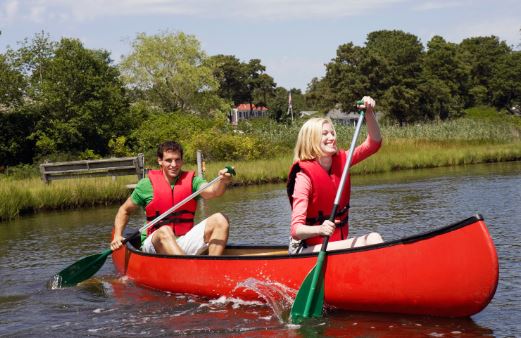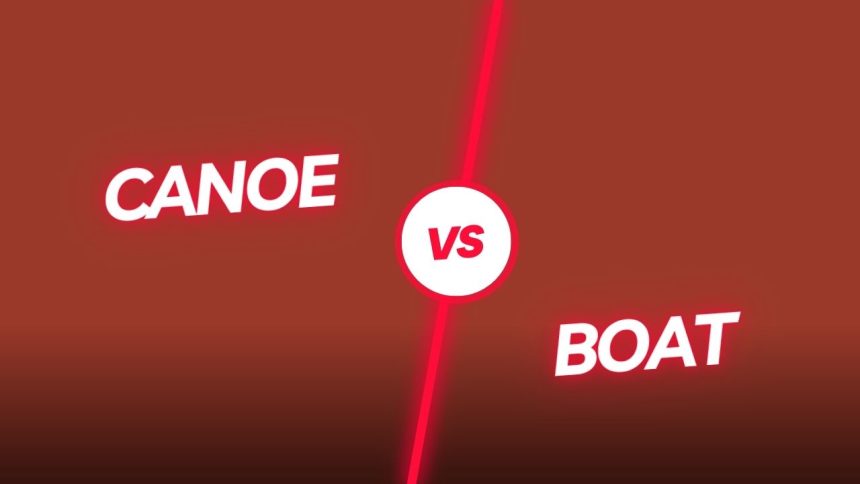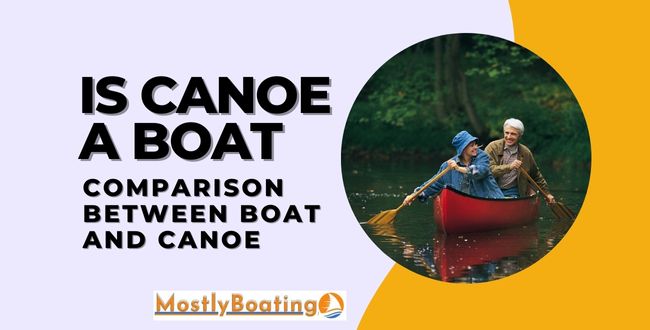When it comes to boating, you have a number of watercraft to explore calm waters on. There are kayaks, paddle boats, surfboards, pedal boats, canoes, and a lot more options. Of all, canoes do hold higher significance pertaining to their lighter weight and easy maneuverability. But did you ever wonder, ‘Is a Canoe a Boat’?
To get an answer to this question, you first need to understand that boat is not a constricted term. Instead, it encompasses a number of water-based vessels, and canoes also fall under this category.
So technically, a canoe is a type of boat that you can use to navigate on waters for both fun and productive activities like fishing.
To clear your further confusion on ‘Is a Canoe a Boat’, I have crafted this comprehensive guide. So let’s not waste more time and get directly into it.
Is a Boat the Same As a Canoe?
No, a boat is not the same as a canoe. While both boats and canoes are watercraft designed to travel on water, there are distinct differences between them.
A canoe is a narrow, lightweight boat that is typically pointed at both ends and open on top. And you have to propel them by paddling with single-bladed paddles.

Canoes are designed to be manually powered and can be used for various purposes, such as recreational paddling, fishing, or transportation. Canoes are usually made of materials like wood, aluminum, fiberglass, or plastic.
On the other hand, the term boat is a more general term that encompasses a wide range of watercraft. Boats come in various sizes, shapes, and designs depending on their intended use.
They can range from small, personal watercraft like canoes and kayaks to large vessels like yachts, sailboats, or motorboats. Unlike canoes, boats may have different forms of propulsion, including oars, paddles, sails, or engines.
We’ve also compared canoes with other water vessels such as:
Pirogue Vs Canoe & Canoe Vs Rowboat
Why is It Called a Canoe?
The word “canoe” originates from the language of the indigenous people of the Americas, particularly from the Carib and Arawak languages.
This term was adopted into English and other languages as a way to refer to the small, narrow boats used by these communities.
Do you know who invented the canoe? It is believed that indigenous peoples are the ones who invented and use the canoe for the very first time.
What is a Canoe Also Known As?
A canoe is also known as a paddle boat or a paddling canoe.
Is a Canoe a Vessel?
Yes, a canoe is considered a vessel. In general maritime and legal terms, a vessel refers to any watercraft or artificial contrivance used, or capable of being used, as a means of transportation on water. If taking about the structure, both canoe length and canoe width is comparatively lesser as compared to regular boats.
Therefore canoes, being watercraft designed for travel on water, fall under the definition of a vessel.
Similarities Between Canoes and Boats

Boats and canoes share several similarities, particularly in their basic design and purpose. Here are some common similarities between both:
Watercraft: Both boats and canoes are types of watercraft designed for travel or recreation on water bodies such as lakes, rivers (whitewater canoeing) and oceans.
Human-Powered: Both types of watercraft can be propelled by human power. While you can operate boats with oars or paddles, canoes are specifically designed for paddling.
Floatation: The design of both boats and canoes facilitate floatation on water. They are typically made from materials that provide buoyancy, such as wood, fiberglass, aluminum, or plastic.
Navigation: Boats and canoes are used for navigation and transportation over water. And you can use them for leisure activities like fishing, exploring, or simply enjoying the water. They are also useful for practical purposes such as transportation or carrying cargo.
Stability: Is canoeing dangerous? Well, not. As Both boats and canoes provide great stability on the water. They have a hull shape that helps maintain balance and prevent capsizing.
Variations in design: Both vessels come in various designs and sizes. You can find them in different shapes and forms, ranging from small and lightweight vessels to larger and more elaborate crafts. There are certain parts of a canoe Thwart or Canoe Spray Deck, which makes it different in structure.
Seating: Both boats and canoes provide seating for occupants. While the seating arrangement and capacity may vary, they generally offer a place for people to sit while navigating the water.
Differences Between Canoes and Boats
Although canoes and boats have several similarities, they also differ in various aspects like:
Weight range
Canoes are generally lighter than most boats. Canoe weight typically ranges between 60 to 80 pounds, depending on the material and design.
Boats, on the other hand, can vary significantly in weight, ranging from lightweight kayaks to large motorized vessels weighing several thousand pounds.
Performance
Canoes are useful primarily for paddling and maneuverability. They have a pointed or V-shaped hull that allows for easy gliding through the water and better maneuvering in narrow or shallow areas. But, incase of flat-bottom canoes , it might not that fast as you expected.
Boats, on the other hand, can have a wide range of performance characteristics depending on their design and purpose. Some boats offer speed and agility, while others prioritize stability and cargo capacity like freighter canoe.
Price
Canoes are generally more affordable compared to boats. The cost of canoes can vary depending on factors such as size, material, and brand, but they tend to be less expensive than most boats.
Boats, especially larger motorized vessels, can be considerably more expensive due to additional components like engines, electronics, and amenities.
Construction
What Are Canoes Made Of? Canoes traditionally have an open design with either no seats or bench-style seats. They often feature a hull made from materials like wood, fiberglass, aluminum, or plastic (inflatable canoes). While, I personally like aluminum as canoeing material, therefore, coleman scanoe is my go-to vessel for long range boating trips.
Boats, on the other hand, can have various designs and constructions, including closed cabins, multiple decks, and specialized features for specific activities such as fishing or sailing.
Size and Capacity
Canoes dimensions are relatively lower and have limited seating capacity, in comparison to the boats. They can accommodate a smaller number of people, usually ranging from one to four individuals.
Boats, however, can vary greatly in size and can accommodate larger groups of people, ranging from a few individuals to dozens or even hundreds.
Power Source
Canoes are powered solely by human effort using paddles. Boats, on the other hand, get their operating power by a variety of sources, including human (such as rowing or paddling), wind (for sailboats), or engines (such as outboard motors or inboard engines).
Cultural and Historical Distinctions of Both of Them
Some factors of cultural and historical distinctions between canoes and boats are as follows:
Canoes
Canoes have a long and rich history, deeply rooted in indigenous cultures around the world. Various indigenous communities used them for transportation, fishing, and trade for thousands of years.
Moreover, canoes also had a crucial role in the exploration and colonization of regions like North America, where European settlers used them for river and lake navigation.
In fact, canoes also hold cultural significance in many indigenous communities, often associated with traditions, storytelling, and spiritual connections to the water and nature.
Boats
The use of boats dates back to ancient times, with evidence of boatbuilding and maritime activities found in civilizations such as ancient Egypt, Mesopotamia, and China.
In addition to this, boats also hold a significant role in the development of human civilization, enabling trade, exploration, and colonization across vast bodies of water.
Lastly, boats have been associated with fishing industries, and naval warfare throughout history, shaping the cultural identities of coastal communities and seafaring nations.
Canoes and Boats Navigational Rules
The basic navigation rules for both watercraft are:
Canoes
Canoes are generally non-motorized vessels and are subject to specific navigational rules depending on the jurisdiction. We can classify them as paddle craft or human-powered vessels.
When it comes to their navigation, you need to follow general boating safety guidelines like wearing canoe life jacket etc. Since, canoe is also considered as a boat (both motorized and non-motorized) therefore you can also get DUI at canoe, if you’re found intoxicated or drinking. These include proper lighting at night, carrying personal flotation devices (PFDs), and observing right-of-way rules to avoid collisions while operating this vessel.
In some regions or water bodies, there may be specific rules or regulations regarding where canoe riding is permitted, canoe speed limits, or designated areas for paddling.
Boats
Boats are subject to various navigational rules and regulations that govern their operation and safety on the water.
Different types of boats, such as sailboats, powerboats, or personal watercraft (PWC), may have specific rules and regulations that pertain to their unique characteristics and capabilities.
For example, while operating powered boats, such as those with motors or sails, you need to follow specific rules regarding navigation lights, sound signals, right-of-way, speed limits, and canoe registration requirements.
Moreover, the navigational rules for boats can vary depending on the country, state, or local jurisdiction. So it is important for you to be aware of and adhere to the specific rules in your area.
Conclusion – What is a Canoe
In conclusion, when discussing watercraft, it is important to recognize that a canoe falls under the broader category of boats. While there are distinct differences in design and purpose between canoes and boats, you can indeed classify a canoe as a type of boat.
With its narrow, lightweight construction and focus on paddling, the canoe offers a unique and versatile watercraft option for recreational activities, exploration, and connecting with nature.
Whether you’re gliding along a serene lake or navigating a winding river, the canoe embodies the spirit of boating, providing an enjoyable and immersive experience on the water. Most important, both boating and canoeing is good exercise form as it engages a number of different muscles and can be used for both adventure and for keeping yourself fit.
FAQs – Is a Canoe a Boat
What is the primary difference between a canoe and a boat?
The primary difference between a canoe and a boat is in their design and purpose. A canoe is a narrow, lightweight, and open watercraft useful for paddling. It usually has a pointed or V-shaped hull that one or more people can operate using paddles.
A boat, on the other hand, is a general term that encompasses a wide range of watercraft, including motorized vessels, sailboats, and various recreational or commercial crafts.
Is a canoe a small boat?
Yes, a canoe is a small boat due to its tinier size and capacity compared to larger vessels, but some people have this confusion that canoes tip over easily, which is nothing but a myth, as elaborated up in the article.
What are two names for canoes?
Two common names for canoes are “canoe” itself and “kayak,” which refers to a specific type of canoe with a closed cockpit design and a double-bladed paddle.
How to pronounce canoe?
The word “canoe” is pronounced as “kuh-noo” with emphasis on the first syllable.

Jack Bennett, a passionate pedal boating enthusiast, and marine engineer by day, is here to share my knowledge and love for this exciting sport with you all. Happy Boating!
